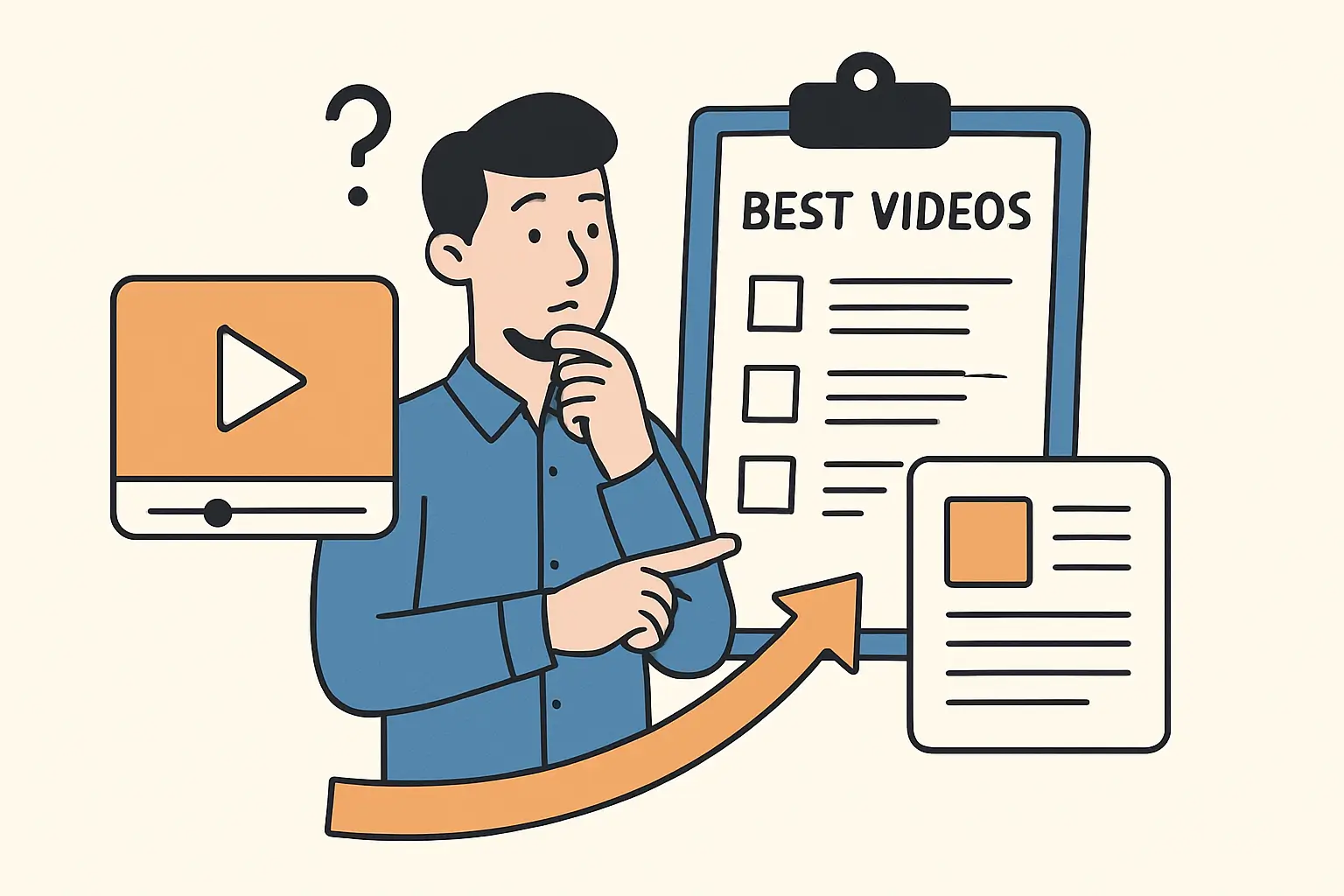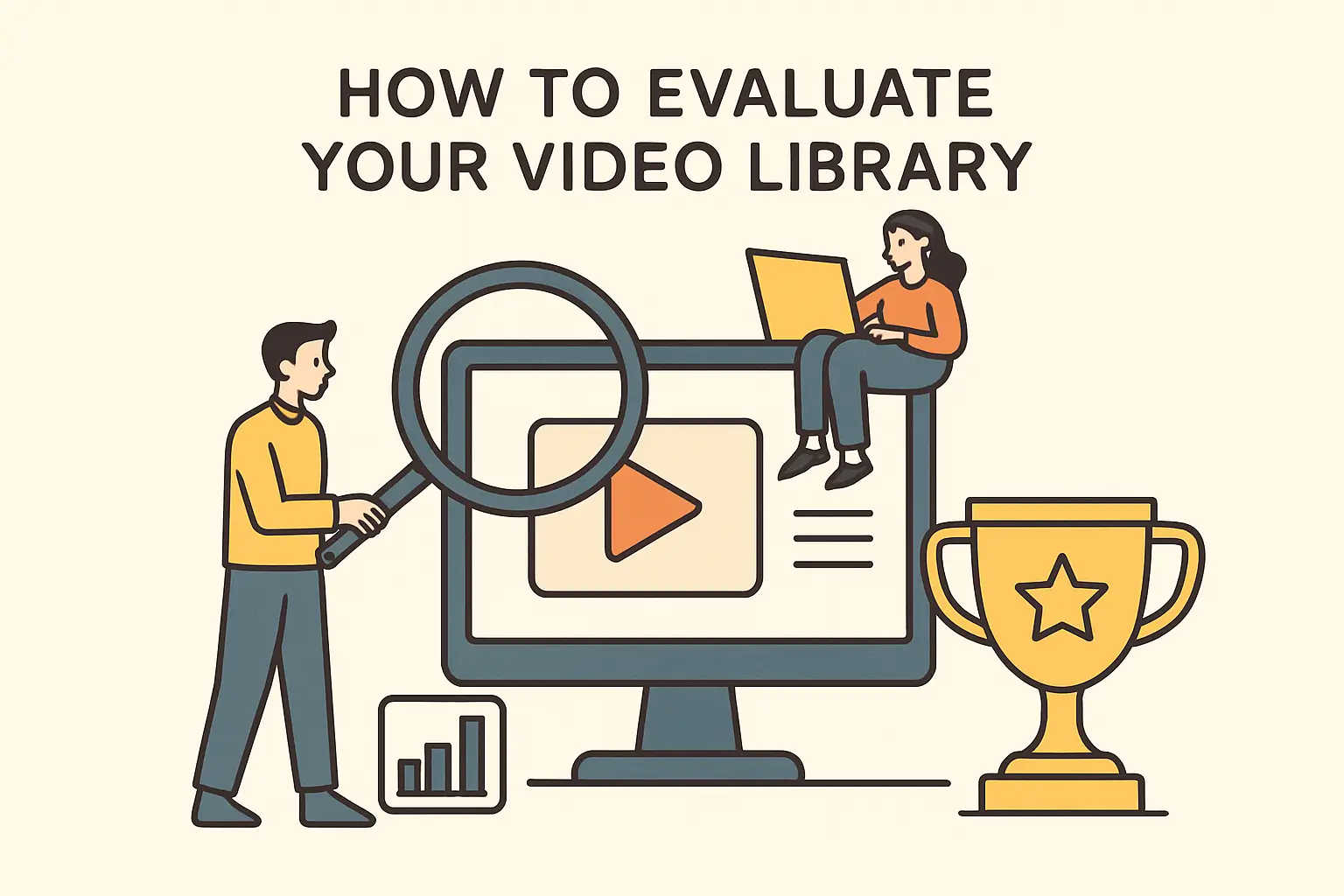How to Choose the Best Videos to Convert into Blog Posts

TL;DR: Choosing the best videos to convert into blog posts involves selecting content that is structured, informative, and relevant to your audience. Ideal videos include tutorials, explainer videos, webinars, and product demos that have a clear narrative, logical flow, and provide substantial information. It's important to evaluate your video library by considering relevance, content depth, quality, performance metrics, and evergreen potential. Prioritizing videos that perform well, cover timeless topics, and align with your blog goals ensures you create valuable, engaging, and sustainable content for your readers.
Table of Contents
What Makes the Best Videos to Convert into Articles?
When you’re staring at a pile of videos, wondering which videos make good blog posts, it helps to know what makes a video a great fit. Not every clip will translate well into written form, but the right ones can save you time and boost your blog’s value.
Types of Videos That Work Best
Look for videos with clear, structured, and informative content. These usually include:
- How-to videos and tutorials: Step-by-step guides are perfect because you can break them down into easy-to-follow sections.
- Explainer videos: They dive deep into a topic, making it simple to expand on key points in writing.
- Webinars and interviews: These often have rich discussions and valuable insights that readers appreciate.
- Product demonstrations: Great for detailed descriptions and highlighting features in your blog.
Videos with strong storytelling or a clear narrative can also be adapted well, as long as the story is relevant and engaging for your audience.
On the flip side, casual or entertainment-focused videos without a clear message or structure tend to be tougher to convert effectively.
Formats and Topics That Translate Well
Videos that naturally lend themselves to written content usually have:
- A logical flow or sequence
- Clear takeaways or FAQs
- Complex information or data that benefits from elaboration
These elements make it easy to organize your blog post with headings, bullet points, and visuals like screenshots or infographics.
For example, a webinar explaining a marketing strategy can be turned into a detailed blog post with actionable tips and examples.
Tip: You can use this app to instantly turn videos into blog posts for free, fully SEO optimized and ready to publish.
Red Flags to Watch Out For
Avoid videos that:
- Are too short or shallow, lacking enough substance to expand on
- Are off-topic or irrelevant to your blog’s niche
- Have poor audio or video quality, making transcription difficult
- Rely mostly on visuals or emotional cues without clear spoken content
- Contain outdated information or topics already covered extensively on your blog
Choosing videos that don’t meet these criteria can waste your time and confuse your readers.
How to Evaluate Your Video Library

If you’ve got a stash of videos gathering digital dust, it’s time to give them a fresh look and find the gems worth turning into blog posts. Here’s how to audit your existing videos without getting overwhelmed.
Step 1: Create a Video Inventory
Start by listing out every video you have. For each one, jot down:
- Title and topic
- Length
- Format (webinar, tutorial, social clip, etc.)
- Performance stats (views, watch time, likes, comments)
This inventory gives you a clear snapshot of what’s in your library and how each video has performed.
Step 2: Use a Checklist to Review Each Video
When you’re ready to dig deeper, run each video through this checklist to see if it’s blog-worthy:
|
Criteria |
What to Look For |
|---|---|
|
Relevance |
Does it match your blog’s niche and audience needs? |
|
Content Depth & Clarity |
Is there enough substance to expand into a post? |
|
Video Length |
Longer videos usually offer more material to repurpose |
|
Audio & Visual Quality |
Clear sound and visuals help with accurate transcription |
|
Performance Metrics |
High views, watch time, and engagement are good signs |
|
Timeliness |
Evergreen content beats trendy stuff for lasting value |
|
Unique Value Potential |
Can you add insights or examples in the blog? |
|
Supporting Materials |
Slides, transcripts, or notes make conversion easier |
Step 3: Prioritize Videos That Hit the Sweet Spot
Focus on videos that:
- Have performed well or show strong engagement
- Cover evergreen topics that stay relevant
- Address common questions or pain points your audience has
- Offer enough depth to create a detailed, valuable blog post
Avoid videos that are too short, shallow, or outdated—they won’t give you much to work with.
Pro tip: Use your YouTube analytics tools to spot hidden winners. Sometimes a video with moderate views but high engagement or comments can be a goldmine for blog content ideas.
By following this simple audit and checklist, you’ll quickly identify which videos are worth your time and effort to convert into compelling blog posts. It’s all about working smarter, not harder, to get the most mileage from your content library.
Matching Video Content to Blog Goals

When you’re turning videos into blog posts, the key is making sure the content fits your blog’s audience and goals like a glove. Here’s how to nail that alignment:
Aligning Video Topics with Your Audience and Goals
Start by getting clear on who your blog readers are and what they care about. Use your analytics tools or even quick surveys to uncover their biggest pain points, interests, and questions. Then, pick videos that speak directly to those areas or complement your blog’s main themes.
Think about what you want your blog to achieve. Are you aiming to educate your audience, generate leads, or build your brand’s authority? For example, if lead generation is your priority, focus on videos that explain your products or services clearly. This way, the blog posts you create won’t just fill space—they’ll resonate with readers and encourage them to take action.
Evergreen vs. Trending Videos: What to Prioritize?
You might wonder whether to lean into evergreen videos or chase trending ones. The smart move is to prioritize evergreen content because it stays relevant and keeps bringing in traffic long after you publish. Evergreen blog posts based on these videos can boost your SEO and provide steady value.
That said, don’t completely ignore trending videos. They’re great for catching waves of current interest and can give your blog a timely boost. The trick is to balance both:
|
Content Type |
Benefits |
When to Use |
|---|---|---|
|
Evergreen |
Long-term SEO, consistent traffic |
Foundation of your blog content |
|
Trending |
Quick spikes in engagement |
To capitalize on current buzz |
Tip: Aim for about 80% evergreen and 20% trending content in your blog strategy. This mix keeps your blog relevant now and valuable later.
By matching your video content thoughtfully to your blog’s goals and audience, you’ll make the most of your video library without feeling overwhelmed.
Conclusion & Next Steps
Choosing the right videos to convert into blog content isn’t just about repurposing, it’s about being strategic. By following these steps, you’ll set yourself up for success.
- Start by auditing your video library using the checklist provided.
- Prioritize videos with lasting value and strong performance.
- Then, align each one with a clear blogging objective, whether it’s educating your audience, generating leads, or boosting SEO.
For a step-by-step guide, check out this ultimate guide to converting videos into blog posts. You’ve got this!
Frequently Asked Questions (FAQ)
What types of videos are best for converting into blog posts?
The best videos for converting into blog posts are tutorials, explainer videos, webinars, interviews, and product demonstrations that have clear structure, valuable insights, and a logical flow.
How can I evaluate my existing video library for blog potential?
You can evaluate your video library by creating an inventory, reviewing each video with a checklist considering relevance, content depth, quality, performance, and evergreen potential, and then prioritizing the most promising ones.
What should I look for in a video to determine if it’s suitable for a blog post?
Look for videos with clear messaging, substantial content, good audio and visual quality, high engagement, and topics that are relevant and evergreen for your audience.
How do I align videos with my blog’s goals and audience?
Align videos with your blog’s goals by choosing content that addresses your audience’s pain points, interests, and questions, and supports your objectives like education, lead generation, or SEO.
Should I focus more on evergreen or trending videos for my blog?
You should focus more on evergreen videos for long-term value and consistent traffic, but incorporating some trending videos can boost current engagement and relevance.
